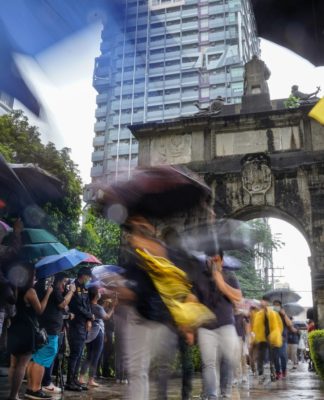THE DEATH of National Artist Nick Joaquin deprived Filipinos of not only the best Filipino writer in English, but also the most generous contributor to the retelling of our nation’s history.
In his necrological services at the Cultural Center of the Philippines last May 4, Joaquin’s niece, Cecile Joaquin-Yasay, said that her uncle was “the family’s storyteller, the one who could transport you back in time to experience what he did when they lived at the banks of the Pasig River.”
It is in the Pasig River that Joaquin wanted his remains to be thrown. As many had claimed, Joaquin loved the river for it brought back memories of the old days when the river was still clean and beautiful.
“He told us that if he dies, we’ll just wrap his corpse in a banig and throw it into the Pasig River,” said the writer Jose Lacaba in his tribute to Joaquin. Joaquin accepted the title of National Artist for Literature in 1976, in the midst of Martial Law, on the condition that Lacaba be released from detention.
After the necrological ceremonies, some of Joaquin’s ashes were thrown in the Pasig River. The rest were stored in a golden urn and laid next to the grave of National Artist for Literature Francisco Arcellana at the Libingan ng mga Bayani in Fort Bonifacio.
Joaquin was also remembered for his lifelong obsession with beer, which he drank to the last few days of his life. It was said that he wrote best when he was drunk, to which CCP’s Lupong Tagapangasiwa head Emily Abrera said, “Aren’t we glad that he drank so much?”
National Artists Napoleon Abueva, Virgilio Almario, Salvador Bernal, Leonor Orosa Goquingco, Arturo Luz, Andrew Veneracion, and Jose paid their respects to Joaquin by laying white flowers next to the urn containing his ashes.
President Macapagal-Arroyo also came to pay homage to Joaquin’s remains last May 1. She declared May 2 as the National Day of Mourning for the late national artist.
Among UST officials who attended the wake or necrological services were former secretary-general Fr. Lamberto Pasion, O.P., Graduate School regent Fr. Antonio Aureada, O.P., and Arts and Letters dean Belen Tangco.
Joaquin, who was born in 1917, was a child of the post-war Philippines, which was then adapting to the American period despite still being deeply rooted to its Spanish heritage. Exposure to this era left him with a deep sense of history, which he embedded in his works.
Joaquin started his adventure with words at the early age of 17, publishing a poem in the pre-war Tribune (Manila Times). More outstanding works followed, including “La Naval de Manila”, an essay that won him a Dominican-sponsored literary award.
In 1949, he went to Hong Kong to study in St. Albert College, a seminary run by the Dominicans. He left the seminary a year later and resumed his literary and journalistic careers in the Philippines, where he wrote articles for the Philippines Free Press under the pen name Quijano de Manila.
UST later awarded Joaquin with an “Associate in the Arts” certificate even if he had not finished his secondary education at the Mapa High School in Intramuros.
After Joaquin’s resignation from the Free Press due to the threat of breaking up a union he was part of, he joined Asia-Philippines Leader in 1971, which was also closed later on the orders of the Marcos administration.
He headed the Philippine Graphic when it saw print in 1990, and was its editor in chief until the time of his death. He wrote a column, “Small Beer” for the Philippine Daily Inquirer and was the publisher of Mirror magazine.
















